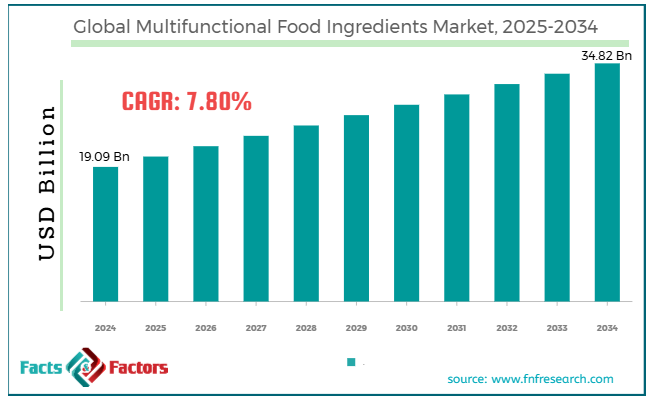Search Market Research Report
Multifunctional Food Ingredients Market Size, Share Global Analysis Report, 2025 - 2034

Multifunctional Food Ingredients Market Size, Share, Growth Analysis Report By Type (Emulsions and Flavors, Hydrocolloids, Fibers, Oat Extracts, Yeast Extracts, Bulking Agents, and Others), By Application (Bakery and Confectionery Products, Meat and Poultry, Dessert and Toppings, Dairy Products, Processed Food Products, and Others), And By Region - Global Industry Insights, Overview, Comprehensive Analysis, Trends, Statistical Research, Market Intelligence, Historical Data and Forecast 2025 - 2034
Industry Insights
[221+ Pages Report] According to Facts & Factors, the global multifunctional food ingredients market size was worth around USD 19.09 billion in 2024 and is predicted to grow to around USD 34.82 billion by 2034, with a compound annual growth rate (CAGR) of roughly 7.80% between 2025 and 2034.

 Market Overview
Market Overview
Multifunctional food ingredients are added to foodstuffs to serve many purposes besides nutrition. They enhance flavor, texture, appearance, shelf life, and health advantages. Common instances comprise stabilizers, emulsifiers, dietary fibers, and antioxidants. These elements help enhance product quality and meet consumer demand, including clean labels, convenience, and functional food products with extra health value.
The global multifunctional food ingredients market is expected to gain momentum over the forecast period, backed by rising health and wellness trends, on-the-go consumption and convenience, and a shift towards clean labels. Consumers actively prefer food products offering certain health benefits like immunity, mental clarity, and enhanced digestion. Multifunctional ingredients like probiotics, prebiotics, and nootropics are being used in food to satisfy these demands.
With busy lifestyles in metro regions, there is a rising preference for ready-made and easy-to-prepare foods. Multi-functional ingredients improve these products' shelf life, nutritional value, and taste, thus increasing their appeal to consumers. Consumers prefer foods with recognizable and natural ingredients and demand transparency in food labeling. This move has developed multi-functional ingredients obtained from natural sources, supporting the clean label movement.
Nevertheless, the global market is constrained by significant research and development costs, regulatory challenges, and consumer skepticism. Developing fresh multifunctional ingredients needs high investment in R&D, which could prevent smaller firms from creating new products.
Also, navigating strict regulations for food elements can be difficult, mainly when launching novel ingredients that may not support the existing segments. Furthermore, despite the advantages, a few consumers remain skeptical about the efficacy and safety of multifunctional ingredients, especially those unfamiliar with synthetic ones.
Yet, the global multifunctional food ingredients industry will progress remarkably due to opportunities like the rising popularity of plant-based advancements and functional beverages. The increasing prominence of plant-based diets offers opportunities for multifunctional ingredients obtained from plants, offering functional and nutritional benefits.
In addition, the growth of functional beverages like energy drinks, fortified waters, and herbal teas offer fresh avenues for integrating ingredients that benefit health.
 Key Insights:
Key Insights:
- As per the analysis shared by our research analyst, the global multifunctional food ingredients market is estimated to grow annually at a CAGR of around 7.80% over the forecast period (2025-2034)
- In terms of revenue, the global multifunctional food ingredients market size was valued at around USD 19.09 billion in 2024 and is projected to reach USD 34.82 billion by 2034.
- The multifunctional food ingredients market is projected to grow significantly due to increasing health consciousness among the large population, rising preference for clean label and natural products, and enhanced shelf life and food safety.
- Based on type, the freestanding racks segment is expected to lead the market, while the double-sided racks segment is expected to grow considerably.
- Based on application, the metal segment is the dominating segment among others, while the plastic segment is projected to witness sizeable revenue over the forecast period.
- Based on region, North America is projected to dominate the global market during the estimated period, followed by Europe.
 Growth Drivers
Growth Drivers
- Will the growing convenience and On-the-Go Consumption boost the multifunctional food ingredients market growth?
With growing hectic lifestyles and mounting time restrictions, people are choosing ready-to-eat snacks and meals that can be easily consumed without sacrificing the required nutrition. Multifunctional ingredients enhance the flavor, texture, and nutritional content of on-the-go foods. Ingredients like stabilizers, emulsifiers, and preservatives are used to maintain the stability of food products, offering better shelf life and making them the most suitable packaged foods.
With the rising demand for ready-made foods, producers rely on multifunctional elements to create products that offer improved nutritional value, appealing taste, and a long shelf life while meeting consumer convenience needs.
Ingredients like protein isolates, fiber, and fortified vitamins are integrated with meal kits, snacks, smoothies, and more, ensuring they are convenient and nutritious. This dependency and consumer expectations may fuel the growth of the multifunctional food ingredients market.
- Changing lifestyles and urbanization notably fuel the market growth
The speedy urbanization witnessed in the emerging economies has majorly transformed food consumption patterns. Urban populations have high spending power, increased preference for ready-to-eat and convenient food products, and more access to packaged foods. This inclination intensifies the demand for foods that are easy to consume and functional. The growing urbanization is directly proportional to the demand for nutritious and on-the-go food products. This offers an opportunity for multifunctional food ingredients that cater to health-conscious groups and people with busy schedules.
Multifunctional ingredients, including fiber, high-protein flour, and antioxidants in instant meals or packaged snacks, are gaining prominence. These elements promise that even take-away meals or fast foods support the nutritional demands of urban consumers.
 Restraints
Restraints
- Does consumer acceptance and perception unfavorably impact the multifunctional food ingredients market progress?
Although multifunctional food ingredients have higher benefits, a few consumers may hesitate to use processed ingredients or additives. Overcoming these perceptions of consumers and guaranteeing acceptance could be problematic for producers.
Moreover, consumers favor food items that add taste and offer extra health advantages like reduced sugar content or fiber enrichment. Multifunctional ingredients that offer advantages such as extended shelf life, enhanced texture, and improved nutritional profiles are highly valued and preferred.
Nevertheless, hesitation and doubtfulness about the efficiency of functional elements, especially with foods that make strong health claims without major scientific support, may hamper the industry's growth.
 Opportunities
Opportunities
- Will the ingredient delivery systems and innovation in processing technologies contribute to the multifunctional food ingredients industry’s progress?
Improved processing methods like nano-delivery systems, microencapsulation, and 3D food printing allow more efficient integration of sensitive multifunctional elements in foods without compromising taste and stability.
This is mainly advantageous for multifunctional materials like antioxidants or probiotics, which may degrade in extreme temperatures like acidity or heat.
Microencapsulation is broadly used to preserve omega-3 fatty acids to cover bitter-tasting ingredients like plant vitamins or proteins, or functional beverages.
In 2024, Ingredion introduced a novel encapsulated vitamin C, designed for heat-processed foods, which promises that the nutrient remains stable during baking and retains its bioactivity, thereby fueling the demand for such foods and the growth of the global multifunctional food ingredients industry.
 Challenges
Challenges
- Ingredient sourcing and supply chain intricacies restrict the growth of the market
Multifunctional ingredients form a complex supply chain, particularly when raw materials are sourced from specific geographic regions or require specialized growing techniques. Factors like geopolitical stresses, climate change, and logistical intricacies may hamper supply chains.
Disturbances in the supply chain may result in the lack of vital ingredients, cost variations, and production delays. These concerns may negatively impact product consistency and availability, affecting consumer trust and brand reputation.
 Report Scope
Report Scope
Report Attribute |
Details |
Market Size in 2024 |
USD 19.09 Billion |
Projected Market Size in 2034 |
USD 34.82 Billion |
CAGR Growth Rate |
7.80% CAGR |
Base Year |
2024 |
Forecast Years |
2025-2034 |
Key Market Players |
Cargill Incorporated, Ingredion Incorporated, Archer Daniels Midland Company (ADM), Tate & Lyle PLC, Kerry Group plc, Givaudan SA, BASF SE, Corbion N.V., Sensient Technologies Corporation, Chr. Hansen Holding A/S, Symrise AG, Roquette Frères, Ashland Inc., Puratos Group, Glanbia plc., and others. |
Key Segment |
By Type, By Application, and Region |
Major Regions Covered |
North America, Europe, Asia Pacific, Latin America, and the Middle East &, Africa |
Purchase Options |
Request customized purchase options to meet your research needs. Explore purchase options |
 Segmentation Analysis
Segmentation Analysis
The global multifunctional food ingredients market is segmented based on type, application, and region.
Based on type, the global multifunctional food ingredients market is divided into emulsions and flavors, hydrocolloids, fibers, oat extracts, yeast extracts, bulking agents, and others. The hydrocolloids segment has led the global market in the past few years. It will continue dominating over the estimated period owing to its versatile uses, improvements in shelf life, and health-based advancements. These ingredients are broadly used in bakery, confectionery, beverages, and dressings.
For instance, pectin is commonly used in jellies and jams, while xanthan gum stabilizes salad dressings. People are actively preferring food products with clean-label, shelf stability, and better mouthfeel. Hydrocolloids help food producers lessen sugar content or reduce fat while maintaining attractive textures. A few hydrocolloids, like beta-glucans and pectin, offer cholesterol-reducing properties, thus increasing their appeal as multifunctional additions in foods.
Based on application, the global multifunctional food ingredients industry is segmented into bakery and confectionery products, meat and poultry, dessert and toppings, dairy products, processed food products, etc. The bakery and confectionery products segment has held a notable CAGR in previous years and is projected to lead due to product innovation, consumer demand, and functional ingredients. Food producers emphasize artisanal and premium products, which are impacted by Western consumer habits in developing regions.
Moreover, there is a rising demand for baked and sweet treats like candies, pastries, cakes, and chocolates. In addition, multifunctional ingredients also enhance texture, improve flavor intensity, and offer better product shelf life and stability.
 Regional Analysis
Regional Analysis
- What will aid North America to witness significant growth in the multifunctional food ingredients market over the forecast period?
North America registered a leading share of the multifunctional food ingredients market, impacted by elevating consumer awareness of food safety, enhanced food manufacturing solutions, and regulatory support. Other key global market drivers include rising health and wellness trends and technological improvements by major companies. Consumers in the region prefer foods that offer health benefits apart from just nutrition. This has surged the demand for elements like prebiotics, probiotics, and plant proteins. Companies like Cargill, ADM, and DoPont are forerunners in developing novel functional food ingredients.
For instance, ADM's acquisition of bio-engineered solutions extended its product portfolio in the gut health segment, while others introduced fresh probiotic ingredients for different food uses. The United States regulatory scenario backs the integration of functional ingredients in food products, supporting modernization and industry growth. The current initiatives have raised awareness among consumers about the benefits of functional food products, further boosting demand.
Europe holds a second-leading market share in the multifunctional food ingredients industry because of regulatory support, high consumer demand, and advancements in food technology. European consumers highly favor health and wellness, resulting in a mounting demand for functional food products that offer more benefits than just nutrition. Economies like Germany strictly comply with quality standards, promising the production of reliable and high-quality food products. This regulatory outlook nurtures advancements and maintains users' trust.
Furthermore, the region is home to prominent companies like DSM-Firmenich, which are forerunners in developing fresh functional ingredients. For instance, DSM-Firmenich aims for roughly 7% yearly sales growth by 2028, emphasizing innovations like dietary supplements and sugar alternatives.
 Competitive Analysis
Competitive Analysis
The global multifunctional food ingredients market profiles companies like:
- Cargill Incorporated
- Ingredion Incorporated
- Archer Daniels Midland Company (ADM)
- Tate & Lyle PLC
- Kerry Group plc
- Givaudan SA
- BASF SE
- Corbion N.V.
- Sensient Technologies Corporation
- Chr. Hansen Holding A/S
- Symrise AG
- Roquette Frères
- Ashland Inc.
- Puratos Group
- Glanbia plc.
 Key Market Trends
Key Market Trends
- Plant-based and clean-label ingredients:
Consumers are actively preferring foods with simple, natural, and recognizable ingredients. This has surged the demand for plant-based ingredients like oat extracts, algae-based omega-3s, pea protein, chia seeds, and more. These elements comply with the clean-label rules and provide extra health benefits, such as protein, fiber, and antioxidants, making them suitable for flexitarian and vegan diets.
- Fat and sugar reduction with functional replacements:
Since health-conscious individuals aim to minimize fat and sugar intake, producers are shifting towards natural sweeteners and multifunctional bulking agents like inulin, erythritol, and stevia that maintain texture, taste, and volume. In confectionery and bakery, these elements enable brands to promote 'no-added sugar' and 'low-sugar' choices without compromising consumer attention.
The global multifunctional food ingredients market is segmented as follows:
 By Type Segment Analysis
By Type Segment Analysis
- Emulsions and Flavors
- Hydrocolloids
- Fibers
- Oat Extracts
- Yeast Extracts
- Bulking Agents
- Others
 By Application Segment Analysis
By Application Segment Analysis
- Bakery and Confectionery Products
- Meat and Poultry
- Dessert and Toppings
- Dairy Products
- Processed Food Products
- Others
 By Regional Segment Analysis
By Regional Segment Analysis
- North America
- The U.S.
- Canada
- Mexico
- Europe
- France
- The UK
- Spain
- Germany
- Italy
- Rest of Europe
- Asia Pacific
- China
- Japan
- India
- Australia
- Southeast Asia
- Rest of Asia Pacific
- The Middle East & Africa
- Saudi Arabia
- UAE
- Egypt
- Kuwait
- South Africa
- Rest of the Middle East & Africa
- Latin America
- Brazil
- Argentina
- Rest of Latin America
Industry Major Market Players
- Cargill Incorporated
- Ingredion Incorporated
- Archer Daniels Midland Company (ADM)
- Tate & Lyle PLC
- Kerry Group plc
- Givaudan SA
- BASF SE
- Corbion N.V.
- Sensient Technologies Corporation
- Chr. Hansen Holding A/S
- Symrise AG
- Roquette Frères
- Ashland Inc.
- Puratos Group
- Glanbia plc.
Frequently Asked Questions

Copyright © 2024 - 2025, All Rights Reserved, Facts and Factors


